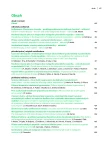Význam EKG u pacientov s resynchronizačnou liečbou
Authors:
Pavol Murín; Peter Mitro; Gabriel Valočik; Peter Spurný; Branislav Stančák
Authors‘ workplace:
Kardiologická klinika LF UPJŠ a VÚSCH, a. s., Košice, Slovenská republika, prednosta MUDr. Stanislav Juhás, CSc.
Published in:
Vnitř Lék 2014; 60(5-6): 431-436
Category:
Original Contributions
Overview
Background:
Cardiac resynchronization therapy (CRT) improves symptoms and survival in patients with chronic heart failure. The presence of electrocardiographic (ECG) signs of electrical dyssynchrony during ventricular contractions are an essential criterion for the implantation of CRT. Nevertheless, 1/3 proportion of patients who undergo CRT do not seem to respond favorably. Aim of study was to investigate the relevant ECG parameters prior to CRT (as well as their postimplantation changes) and to determine their relation to predicting favorable response to CRT.
Methods:
52 symptomatic patients (age 62.2 ± 10.5 years, 39 men) with severe left ventricular (LV) systolic dysfunction (ejection fraction 26.3 % ± 6.9 %) with QRS ≥ 120 ms underwent CRT implantation. In early pre- and postimplantation CRT period the following ECG parameters were recorded: QRS complex width and morphology (complete and atypical left bundle branch block, nonspecific intraventricular conduction delay), the size of R and S wave. After 6 months of CRT, responders were definied by improvement of LV ejection fraction > 5 % and/or reduction of end-systolic LV volume > 15 %.
Results:
The incidence of left bundle branch block (complete or atypical) prior to CRT implantation was higher in responders compared to non-responders group (64 % vs 35 %, p = 0.036). After implantation of CRT, responders showed significant narrowing of the QRS complex, while non-responder`s QRS complex width remained unchanged (∆QRS -18 ± 22 ms vs 1 ± 27 ms, p = 0.018). Furthermore QRS complex reduction led to increase in LV ejection fraction (r = 0.47, p = 0.001) and to reduction of LV end-systolic volume (r = 0.42, p = 0.004). ∆R and ∆S changes between responders and non-responders did not differ (p = 0.598 respectively, P = 0.685).
Conclusion:
The presence of complete left bundle branch block before CRT implantation is associated with a better response to CRT compared to other myocardial intraventricular conduction disturbances. Post-implantation narrowing of QRS complex appears to be an early predictor of favorable response to CRT.
Key words:
cardiac resynchronization therapy – QRS morphology and narrowing – responder
Sources
1. McMurray JJ, Adamopoulos S, Anker SD et al. ESC Guidelines for the diagnosis and treatment of acute and chronic heart failure 2012: The Task Force for the Diagnosis and Treatment of Acute and Chronic Heart Failure 2012 of the European Society of Cardiology. Developed in collaboration with the Heart Failure Association (HFA) of the ESC. Eur J Heart Fail 2012; 14(8): 803–869. Erratum in: Eur J Heart Fail 2013; 15(3): 361–362.
2. Wilinski J, Czarnecka D, Wojciechowska W et al. Different response rates to cardiac resynchronization therapy (CRT) according to the applied definition. Przegl Lek 2009; 66(3): 130–133.
3. Murín P, Mitro P, Valočik G et al. Význam globálnej kontraktilnej rezervy u pacientov s resynchronizačnou liečbou. Vnitř Lék 2012; 58(1): 13–17.
4. Murín P, Mitro P, Valočik G et al. Resynchronizačná liečba srdcového zlyhávania – stále veľa otáznikov. Vnitř Lék 2011; 57(10): 819–825.
5. Táborský M, Kautzner J, Bytešník J et al. Zásady pro implantace kardiostimulátorů a implantabilních kardioverterů-defibrilátorů a srdeční resynchronizační léčbu. Cor Vasa 2005; 47(Suppl 9): S59-S68.
6. Rickard J, Popovic Z, Verhaert T et al. The QRS narrowing index predicts reverse left ventricular remodeling following cardiac resynchronization therapy. Pacing Clin Electrophysiol 2011; 34(5): 604–611.
7. Leclercq C, Faris O, Tunin R et al. Systolic improvement and mechanical resynchronization does not require electrical synchrony in the dilated failing heart with left bundle-branch block. Circulation 2002; 106(14): 1760–1763.
8. Ghio S, Constantin C, Klersy C et al. Interventricular and intraventricular dyssynchrony are common in heart failure patients, regardless of QRS duration. European Heart Journal 2004; 25(7): 571–578.
9. Linde C, Gold MR, Abraham WT et al (REVERSE – REsynchronization reVErses Remodeling in Systolic left vEntricular dysfunction Study Group). Randomized trial of cardiac resynchronization in mildly symptomatic heart failure patients and in asymptomatic patients with left ventricular dysfunction and previous heart failure symptoms. J Am Coll Cardiol 2008; 52(23): 1834–1843.
10. Yu CM, Bleeker GB, Fung JW et al. Left ventricular reverse remodeling but not clinical improvement predicts long-term survival after cardiac resynchronization therapy. Circulation 2005; 112(11): 1580–1586.
11. Moss AJ, Hall WJ, Cannom DS et al. MADIT-CRT Trial Investigators. Cardiac-resynchronization therapy for the prevention of heart-failure events. N Engl J Med 2009; 361(14): 1329–1338.
12. Perrin MJ, Green MS, Redpath CJ et al. Greater response to cardiac resynchronization therapy in patients with true complete left bundle branch block: a PREDICT substudy. Europace 2012; 14(5): 690–695.
13. Hsing JM, Selzman KA, Leclercq C. Paced left ventricular QRS width and ECG parameters predict outcomes after cardiac resynchronization therapy: PROSPECT-ECG substudy. Circ Arrhythm Electrophysiol 2011; 4(6): 851–857.
14. Giudici MC, Tigrett DW, Carlson JI et al. Patterns in cardiac resynchronization therapy. Pacing the great cardiac and middle cardiac veins. Pacing Clin Electrophysiol 2007; 30(11): 1376–1380.
15. Porciani MC, Dondina C, Macioce R et al. Temporal variation in optimal atrioventricular and interventricular delay during cardiac resynchronization therapy. J Card Fail 2006; 12(9): 715–719.
16. Barold SS, Herweg B, Giudici M. Electrocardiographic follow-up of biventricular pacemakers. Ann Noninvasive Electrocardiol 2005; 10(2): 231–255.
Labels
Diabetology Endocrinology Internal medicineArticle was published in
Internal Medicine

2014 Issue 5-6
Most read in this issue
- Adult-onset Still’s disease – a difficult path to diagnosis through fever and effusions of unknown origin
- Purple urine bag syndrome – rare but substantial symptom of urinary infection
- Sentinel lymph node in malignant melanoma
- Diffuse Idiopathic Skeletal Hyperostosis
